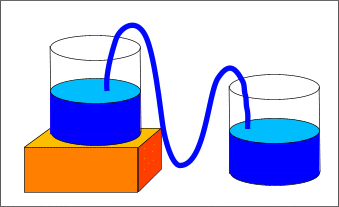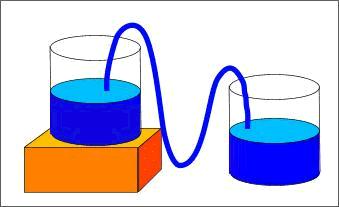Science of the Comstock - Physics
Home | Tour | Physics | Chemistry | Earth Science | Environment | Scams | Lesson Plans
Physics Topics:
Introduction
Siphons
Timbering
Siphons
Introduction

Situated in the high desert of the Great Basin, newly settled Virginia City had a very scarce local water supply. Mines and mills required a great quantity of water as did the people of Virginia City, whose population had grown to 30,000. Early in the town's history wells and springs supplied some water, and some could be bought from carts that peddled water around town. Small reservoirs were built to contain melting snow, and abandoned mine shafts were used to store water, but the supply was still insufficient and of very poor quality. The Virginia and Gold Hill Water Company was formed to collect as much water as possible into wooden storage tanks and to tap into underground resources. The demands of the population and mines quickly drained these resources, and finally the town resorted to bilge water from the mines. This was impure and made residents sick.
Water would have to come from somewhere else if the town were to survive. An amazing engineering feat was attempted. Water would be transported from the Sierra Nevada 25 miles away, through a pipe over the Virginia Range to water a thirsty Virginia City. It took only one summer to lay the pipe, which provided daily 2 million gallons of cold pure water. This capacity was still not enough, and, to meet demand, within two years the pipeline had to be pushed eight miles further into the Sierras to a newly dammed Marlette Lake.
Step 1

Water from the Sierras is transported from Virginia City twenty five miles away. An inverted siphon is used to move the water with little energy input.
Step 2

Water was carried from Marlette Lake at an elevation of 7838 feet above sea level through four and a half miles of wooden flumes to the tanks at the head of the pipe. For a siphon to work the level of the water at the source must be higher than the water at the end.
Step 3

When the valve was opened at the tank, water flowed into an eleven and a half inch diameter iron pipe that varied in thickness from .06 inches to .31 inches depending on the pressure of the water that was flowing through it. Water falls 1,887 feet to its lowest point in Washoe Valley. This fall generates 819 pounds of pressure per square inch in the pipe.
Step 4

This pressure causes water to be forced up the pipe to the other side of the valley across the Virginia Range to Five Mile reservoir. This is 1500 feet above the pipe's lowest level in Washoe Valley and 120 ft. above Virginia City's main water tank.
Step 5

A siphon will move water over a mountain, down a valley, and up the other side. A siphon works because there are unequal pressures exerted on the water at the source and at the end of the water pipe, due to different elevations at the beginning and end of the water pipes. The higher the level of water, the more pressure will be exerted.
Student Activity: Make your own model of a siphon
Step 1: Gather the materials.
You'll need:
Two beakers or glasses half filled with water
Rubber or plastic tubing, about 50 cm
Step 2: Procedure
-Fill the tubing with water from the faucet or by immersing it in a bowl of water. Cover the ends of the water-filled tube with your fingers and lower one end of the tubing into each of the beakers. Take your fingers off leaving the ends of the tube under water in each beaker.
-Raise one of the beakers so its water level is higher than the second beaker's water level and watch what happens. Now, switch the levels of the beakers so the second beaker is higher than the first. Watch what happens. Then put both beakers at the same level on the table and watch what happens to the water levels in the beakers.

What's happening?
Did the lower glass fill up with water? When you switched the levels of the beakers, did the water run into the first beaker? As you watched, did the levels of water in each beaker even out when they where both set on the same level?
When both legs of the siphon are full, because of gravity, the hydrostatic force (the force of the water) is greater on the higher side of the tube. This means the liquid will move up the lower leg of the tube, over the rim of the beaker and into the lower beaker. Once started the flow will continue until the water levels are equal. Then the hydrostatic forces on each leg of the tube will also be equal.
Step 3: Observe
Write down what you observe.
Using what you know about science make a hypothesis about why this happens.
Write down some other ways you think this process could be used.


 Home
Home